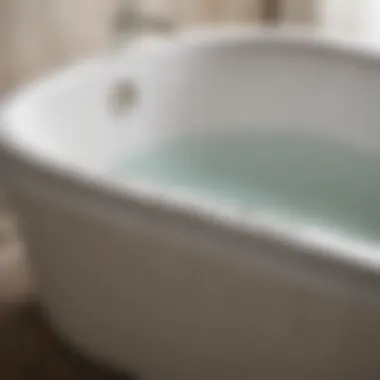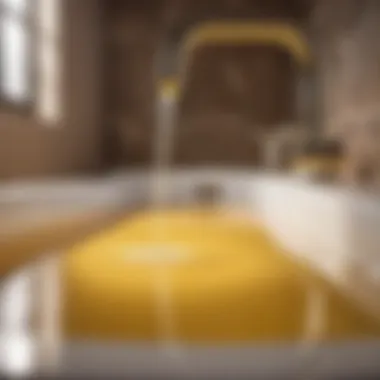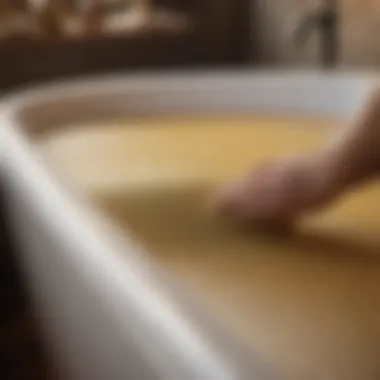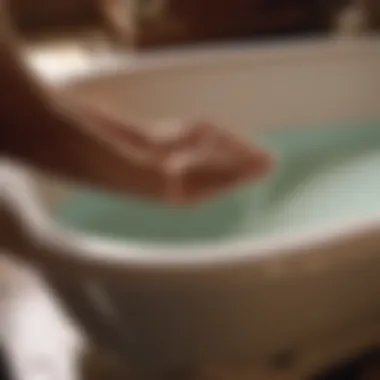Expert Guide on Repairing a Plastic Bath for Lasting Solutions


Materials:
- Plastic bath repair kit including filler compound and sandpaper (quantities specified in kit instructions)
- Protective gloves
- Masking tape
- Cleaning solution
- Towels for drying
- HVLP spray gun
DIY Steps:
- Start by cleaning the damaged area of the plastic bath with the cleaning solution and allow it to dry completely.
- Put on protective gloves to prevent any skin irritations from chemicals.
- Use masking tape to outline the repair area and protect surrounding surfaces from accidental damage.
- Prepare the filler compound as per the kit's instructions, ensuring the right ratio of hardener to filler.
- Apply the filler compound to the damaged area, smoothing it out evenly with a spatula.
- Allow the compound to cure as per the kit instructions and sand it down to a smooth finish.
- Wipe down the repaired area with a clean towel to remove any dust or debris.
- Use the HVLP spray gun to apply a finishing coat to blend the repair seamlessly with the rest of the bath.
- Allow the final coat to dry as specified before using the bath again.
Technical Aspects:
- Tools: Detailed mainly above, stay tuned for the next detailed steps and stages.
- Timing: Ensure each layer of compound is fully cured before proceeding to the next step.
- Critical Techniques: Sanding in between layers for a smooth finish, proper application of the finishing coat for a seamless repair.
DIY Project Process:
- Detailed Installation Method: The careful application of filler compound and sanding for a flawless finish.
- Key Techniques and Timings: Ensure each step is done meticulously and allow ample time for curing and drying.
- Troubleshooting Tips: If the repair looks uneven, sand down and reapply filler compound.
Providing detailed instructions and precise measurements is crucial to achieving a professional repair on your plastic bath. By following these steps carefully, you can restore your bath to its former glory effectively.
Understanding the Problem
In the realm of repairing a plastic bath, the significance of understanding the problem at hand cannot be overstated. A crucial aspect of effective repair work lies in correctly identifying and assessing the issues plaguing the bath. By comprehensively understanding the problem, you lay a solid foundation for successful repairs, ensuring long-lasting results without recurrent issues. This section delves into the core elements that revolve around grasping the problem, setting the stage for a meticulous and thorough repair process.
Assessment of Damage
Cracks
Cracks in a plastic bath present a common yet challenging issue that demands attention to detail. These fissures not only compromise the structural integrity of the bath but also pose the risk of water leakage and further damage if left unaddressed. Understanding the depth and extent of these cracks is pivotal in determining the appropriate repair techniques required to restore the bath to its original condition. Despite their negative implications, cracks provide an opportunity for precise intervention, allowing for targeted repairs that strengthen the bath's overall resilience. However, one must proceed with caution, as mismanagement of crack repairs can lead to worsening of the initial damage, underscoring the importance of thorough assessment and expert handling.
Chips
Chips, though seemingly minor, can detract from the aesthetic appeal and functionality of a plastic bath. These small, exposed areas not only detract from the overall visual appeal but also increase the likelihood of further damage if not promptly addressed. The key characteristic of chips lies in their propensity to expand over time, making immediate attention imperative to prevent exacerbation of the issue. Despite their discreet nature, chips can be indicative of underlying structural weaknesses, emphasizing the need for comprehensive examination and tailored repair solutions to fortify the bath against future deterioration.
Discoloration
Discoloration in a plastic bath serves as a visible manifestation of underlying issues that go beyond surface-level aesthetics. While discoloration may seem purely cosmetic, it often indicates exposure to harsh chemicals, age-related wear, or improper cleaning practices. Understanding the root cause of discoloration is crucial in devising an effective restoration plan that not only addresses the surface blemishes but also tackles the underlying factors contributing to the fading hues. By evaluating the extent of discoloration and its underlying causes, one can implement targeted solutions that not only restore the bath's appearance but also enhance its longevity and resilience against future discoloration.
Identifying the Cause
Improper Maintenance
Improper maintenance stands out as a primary culprit behind a myriad of plastic bath issues, ranging from cracks to discoloration. Neglecting regular cleaning, using harsh chemicals, and suboptimal usage habits can all contribute to the deterioration of a plastic bath over time. The telltale signs of improper maintenance often manifest in the form of staining, cracking, and dulling of the bath surface, pointing towards the need for proactive care and maintenance practices. By identifying lax maintenance routines as a contributing factor, individuals can rectify their habits and adopt preventive measures to uphold the bath's condition and prolong its lifespan.


Impact Damage
Impact damage poses a significant threat to the structural integrity and appearance of a plastic bath, often resulting from accidental knocks or falls. The sudden force exerted during such incidents can lead to cracking, chipping, or even structural deformities, necessitating immediate attention to mitigate the damage. Recognizing the implications of impact damage involves assessing the extent of the harm and formulating remedial actions that reinforce the affected areas and prevent further deterioration. Through prompt identification and targeted repairs, individuals can effectively address impact damage, restoring the bath to its former state and safeguarding it against future accidents.
Chemical Exposure
Chemical exposure represents a common yet overlooked factor contributing to plastic bath degradation. The prolonged contact with abrasive cleaners, strong chemicals, or incompatible substances can result in discoloration, surface etching, and material erosion, detracting from the bath's overall appearance and functionality. Acknowledging the role of chemical exposure in bath damage involves scrutinizing the cleaning products used, minimizing unnecessary exposure to harmful substances, and opting for mild, bath-safe alternatives. By understanding the impact of chemical exposure on bath integrity, individuals can tailor their cleaning practices to preserve the bath's finish, color, and durability, ensuring long-term performance and visual appeal.
Preparation for Repair
When it comes to repairing a plastic bath, adequate preparation is the key to a successful outcome. In this article, the section on Preparation for Repair serves as a crucial foundation for the entire repair process. By focusing on specific elements such as Gathering Materials and Surface Preparation, this segment ensures that you are well-equipped to tackle the repair with precision and effectiveness.
Gathering Materials
Repair Kit
A fundamental aspect of the preparation phase is assembling the necessary materials, with the Repair Kit playing a central role. This kit typically includes items like epoxy resin, mixing tools, applicators, and finishing materials. The versatility and completeness of the Repair Kit make it an essential component for addressing various types of damage to a plastic bath.
The key characteristic of a Repair Kit lies in its ability to provide all-in-one solutions for repairing cracks, chips, and discoloration effectively. Its convenience and ease of use make it a popular choice for individuals looking to undertake plastic bath repairs themselves. One unique feature of a Repair Kit is its user-friendly instructions and compatibility with different types of plastic baths, ensuring a seamless repair process.
Safety Equipment
In addition to the Repair Kit, safety should always be a top priority during plastic bath repair. Safety Equipment such as gloves, masks, and goggles are crucial for protecting yourself from harmful fumes and chemicals. Prioritizing safety not only safeguards your well-being but also enhances the overall repair experience by minimizing risks and ensuring a controlled environment.
The key characteristic of Safety Equipment is its ability to provide comprehensive protection throughout the repair procedure. Its popularity stems from the peace of mind it offers, knowing that you are safeguarded against any potential hazards. A unique feature of Safety Equipment is its ergonomic design, which ensures comfort and functionality while working on repair tasks.
Cleaning Supplies
Another vital component of preparation is the inclusion of Cleaning Supplies in your arsenal. These supplies may include cleaners, degreasers, and sponges designed specifically for pre-repair surface cleaning. Thorough cleaning is essential for removing debris, oils, and contaminants that could affect the repair's adhesion and overall quality.
The key characteristic of Cleaning Supplies is their ability to facilitate a clean and pristine surface for repair work. Their effectiveness in eliminating dirt and grime makes them a popular choice for ensuring optimal repair results. A unique feature of Cleaning Supplies is their compatibility with various plastic bath materials, allowing for tailored cleaning solutions depending on the type of damage present.
Surface Preparation
Cleaning
One of the first steps in surface preparation is cleaning the damaged area thoroughly. Cleaning involves using appropriate cleaners and solvents to remove any existing residue, soap scum, or hard water deposits. This ensures that the repair materials adhere properly to the surface, promoting a durable and long-lasting fix.
The key characteristic of the cleaning process is its role in establishing a clean and receptive surface for repair applications. Its popularity lies in the fact that it significantly enhances the bond between the repair materials and the plastic bath surface. A unique feature of cleaning is its ability to uncover hidden damage and provide a clear view of the repair scope before proceeding further.
Drying


Once the cleaning process is completed, drying the surface becomes imperative before proceeding with any repair work. Drying involves using clean, dry towels or cloths to eliminate moisture from the damaged area thoroughly. Proper drying ensures that the repair materials adhere effectively, preventing any bubbling or peeling post-repair.
The key characteristic of drying is its ability to promote optimal adhesion and curing of repair materials on the plastic bath surface. Its popularity stems from the fact that moisture-free surface conditions are essential for a successful repair outcome. A unique feature of drying is its contribution to preventing future water-related damage that could compromise the repair's longevity.
Sanding
To further prepare the surface for repair, sanding plays a crucial role in smoothing out rough edges, creating a uniform texture, and enhancing adhesion. Sanding involves using fine-grit sandpaper to gently sand the damaged area, promoting a seamless integration of the repair materials into the existing surface.
The key characteristic of sanding is its ability to refine the surface and promote a level foundation for repair applications. Its popularity lies in the precision and control it offers in achieving a smooth and even surface for subsequent repair steps. A unique feature of sanding is its capacity to blend the repair area with the surrounding surface, ensuring a visually appealing and structurally sound repair finish.
Repair Techniques
In the comprehensive guide on repairing a plastic bath, understanding and mastering repair techniques are paramount. Repair techniques encompass a range of skills and methods essential for addressing various issues that may arise with a plastic bath. These techniques not only help in restoring the aesthetic appeal of the bath but also ensure its structural integrity and longevity. By focusing on repair techniques, individuals can effectively tackle common problems such as cracks, chips, and discoloration, ultimately enhancing the overall quality and durability of the plastic bath.
Filling Cracks and Chips
Epoxy Resin Application
Epoxy resin application stands out as a crucial aspect of repairing cracks and chips in a plastic bath. This method involves using epoxy resin, a durable and adhesive substance that effectively fills and seals cracks and chips, preventing further damage and leakage. The key characteristic of epoxy resin application lies in its ability to create a strong and watertight bond, ensuring a long-lasting repair solution. This technique is a popular choice for repairing plastic baths due to its durability, flexibility, and resistance to water and chemicals. While epoxy resin application offers exceptional adhesion and strength, one must carefully follow the application process to achieve optimal results.
Sanding and Smoothing
Sanding and smoothing play a pivotal role in the repair process after filling cracks and chips with epoxy resin. This step involves carefully sanding down the repaired areas to achieve a smooth and seamless finish. The key characteristic of sanding and smoothing is their ability to blend the repaired sections with the rest of the surface, creating a uniform look. This technique is favored for its ability to refine the texture and appearance of the repaired areas, ensuring a professional and polished outcome. While sanding and smoothing contribute to a flawless repair finish, proper technique and attention to detail are essential to avoid over-sanding or damaging the plastic surface. By meticulously executing the sanding and smoothing process, individuals can achieve a seamless repair that seamlessly integrates with the original bath design.
Color Restoration
Color restoration holds significance in the overall repair process of a plastic bath, as it aims to restore the bath's original color and visual appeal. An essential aspect of color restoration is matching the original color of the bath to maintain its aesthetic harmony. This process involves selecting the appropriate color-matching techniques and products to achieve a seamless blend between the repaired and existing areas. The key characteristic of matching the original color lies in its ability to conceal repairs effectively, creating a cohesive and natural look. This technique is essential for achieving a visually pleasing result that seamlessly integrates the repair work with the overall design of the plastic bath.
Finishing Techniques
Finishing techniques play a crucial role in completing the repair process and enhancing the overall look and feel of the plastic bath. The key characteristic of finishing techniques is their ability to add a protective layer, improve durability, and enhance the visual appeal of the repaired areas. By employing the right finishing techniques, individuals can achieve a smooth and glossy finish that revitalizes the appearance of the plastic bath. This technique is popular for its ability to elevate the aesthetics of the repaired sections while providing long-lasting protection against water damage and daily wear and tear. While finishing techniques contribute to a polished outcome, proper application and detailing are essential to ensure a flawless and enduring finish.
Structural Integrity Repairs
Structural integrity repairs are crucial for reinforcing the strength and stability of a plastic bath after damage. These repairs focus on strengthening the weakened areas and preventing further deterioration, ensuring the bath's long-term functionality. One key aspect of structural integrity repairs is the selection of effective reinforcement methods that enhance the overall durability of the bath. This process involves implementing sturdy materials and techniques to fortify weakened sections, thus improving the bath's resistance to future damage. While reinforcement methods provide essential support and protection, careful consideration of the application technique and compatibility with the plastic material is necessary to achieve optimal results.
Sealing
Sealing serves as a vital step in ensuring the longevity and water resistance of a repaired plastic bath. The key characteristic of sealing is its ability to create a protective barrier that prevents moisture infiltration and maintains the integrity of the repair work. Sealing is a popular choice for enhancing the durability and longevity of repaired areas, safeguarding them against water damage and stains. By selecting high-quality sealants and following proper sealing procedures, individuals can effectively protect the repaired sections and prolong the lifespan of the plastic bath. While sealing contributes to the overall resilience of the bath, meticulous application and maintenance are essential to ensure the seal remains intact and effective over time.
Finishing Touches


In the realm of repairing a plastic bath, the final touches play a crucial role in not only restoring the bath's appearance but also ensuring its longevity. Paying attention to detail during the finishing touches stage sets the tone for a job well done and a bathtub that looks as good as new. In this comprehensive guide on repairing a plastic bath, the section on Finishing Touches emphasizes the importance of these final steps in the repair process. From restoring the original shine to sealing the repaired areas, each aspect contributes to the overall success of the project.
Polishing and Buffing
Smoothing the Surface:
Within the context of plastic bath repair, smoothing the surface is a critical step that helps achieve a seamless finish. By meticulously smoothing out any imperfections or rough patches, you not only enhance the visual appeal but also ensure a uniform surface ready for the next stages of repair. The key characteristic of this process lies in its ability to create a flawlessly smooth surface, pivotal for a professional-looking outcome. The technique of smoothing the surface is a popular choice in this article as it sets the foundation for a polished and refined bathtub repair. Despite its meticulous nature, the advantages of smoothing the surface are manifold, ensuring that all repairs blend seamlessly with the original structure.
Enhancing Shine:
Another essential aspect of the finishing touches is enhancing the shine of the plastic bath. This step involves applying specific products or techniques to bring out the luster of the surface, elevating its overall aesthetic appeal. By enhancing the shine, you not only complete the repair process but also create a visually striking result. The key characteristic of enhancing shine is its ability to rejuvenate the plastic bath, giving it a glossy finish that enhances its appearance. This choice is widely favored in the article for its transformative impact, breathing new life into worn-out or damaged surfaces. While enhancing shine enhances the visual appeal, it also adds a layer of protection to the repaired areas, ensuring durability and long-lasting results.
Sealing and Waterproofing
Protective Coatings:
When it comes to sealing and waterproofing the repaired plastic bath, protective coatings play a vital role. These coatings form a protective barrier over the surface, safeguarding it from moisture, chemicals, and everyday wear and tear. The key characteristic of protective coatings is their ability to provide a durable shield that prolongs the lifespan of the repair work. In this article, protective coatings are highlighted for their effectiveness in sealing and enhancing the overall integrity of the plastic bath. The unique feature of protective coatings lies in their versatility and ability to adapt to various surface materials, making them a popular choice for sealing and protecting plastic baths. While protective coatings offer excellent protection, it is essential to consider their maintenance requirements and application techniques for optimal results.
Water-resistant Sealants:
In the realm of plastic bath repair, water-resistant sealants serve as the final protective layer that ensures the repaired areas remain waterproof and resistant to moisture infiltration. These sealants play a critical role in preventing water damage and maintaining the structural integrity of the bath. The key characteristic of water-resistant sealants is their ability to create a watertight seal that prevents leaks and water penetration. This choice is favored in the article for its efficacy in sealing repaired cracks and chips, providing long-term protection against water-related issues. The unique feature of water-resistant sealants lies in their flexibility and durability, making them a practical choice for sealing and waterproofing plastic baths. While offering excellent waterproofing capabilities, it is essential to consider the compatibility of sealants with different surfaces and their application techniques for optimal results.
Maintenance Tips
Maintaining a plastic bath is crucial to ensure its longevity and functionality. In this section, we will delve into key maintenance tips that will help you preserve and protect your plastic bath effectively.
Preventive Measures
Taking preventive measures is essential in upholding the condition of your plastic bath.
Regular Cleaning
One of the most fundamental aspects of maintenance is regular cleaning. Regularly cleaning your plastic bath helps prevent the buildup of grime, soap scum, and mildew, ensuring a hygienic bathing environment. By incorporating regular cleaning into your maintenance routine, you not only maintain the aesthetics of your bath but also prevent the development of stubborn stains.
Avoiding Harsh Chemicals
Avoiding harsh chemicals is paramount in safeguarding the integrity of your plastic bath. Harsh chemicals can damage the surface of the bath, leading to discoloration or degradation over time. By opting for gentle, non-abrasive cleaning products, you can effectively clean your plastic bath without compromising its quality or finish.
Long-Term Care
Long-term care strategies are essential to prolonging the life of your plastic bath and maintaining its pristine condition.
Periodic Inspections
Conducting periodic inspections allows you to detect any potential issues or wear and tear early on. By regularly inspecting the condition of your plastic bath, you can spot minor damages before they escalate into more extensive problems, enabling timely repairs and maintenance.
Prompt Repairs
Prompt repairs are key to addressing any identified issues swiftly and preventing further damage. Whether it's repairing minor cracks or addressing leaks, attending to repairs promptly ensures that your plastic bath remains structurally sound and functional. Prompt repairs contribute to the overall maintenance of your bath, prolonging its lifespan and minimizing repair costs over time.







